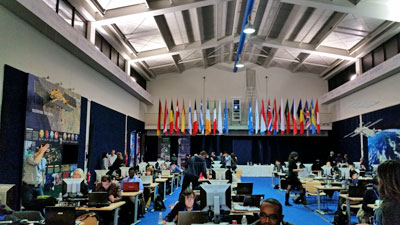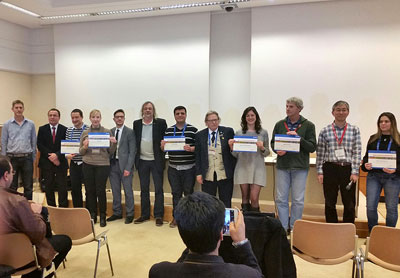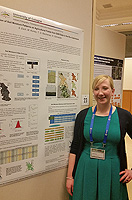| Photo: Poster session Copyright: Sabrina Esch |
Sabrina Esch has received the IRTG Winter School Grant 2015 to attend the 3rd ESA Advanced Course on Radar Polarimetry (19.-23. Jan 2015) and the 7th International Workshop on Science and Application of SAR Polarimetry and Polarimetric Interferometry (POLinSAR 2015) and 1st BIOMASS Science Workshop (26. – 30. Jan 2015) in ESA ESRIN Frascati, Italy
I already visited the 5th ESA Advanced Course on Land Remote Sensing in Valencia, Spain in 2014, which was an excellent experience of learning all the basics and advanced concepts of SAR remote sensing. One of the lecturers there advised me to apply for the Advanced Course on Radar Polarimetry, as it is more specialized than the previous course. He also encouraged me to come with a poster to POLinSAR 2015. It was a great opportunity, because both the course and the workshop took place at ESA ESRIN in successive weeks. People attending the course were a mixture of PhD students, Postdocs and Master students coming from all over the world. Attending the course was helpful to meet people working in similar fields. I even met a Postdoc who did her PhD on a quite similar topic to mine several years ago and was able to have some great discussions for example about practical problems of data collection.
The course started every morning with presentations about recent or upcoming SAR-missions and was then comprised of theoretical lectures until lunch. After the lunch break we concluded the topics of the mornings' lectures with practical exercises using PolSARpro and the Sentinel-1 Toolbox software. Our topics evolved from PolSAR basics, advanced concepts and Pol-TomSAR to applications on surface parameters estimation. Our teachers were Prof. Eric Pottier, Dr. Chris Stewart, Dr. Stefano Tebaldini, Prof. Laurent Ferro-Famil and Prof. Irena Hajnsek. The last day consisted of talks about PolSAR applications by different experts and presentations of new missions. The course was concluded with a keynote address by Prof. Wolfgang-Martin Boerner, who talked about the history of remote sensing and future challenges.
The day dedicated to surface parameter estimation was of special interest to me, as Prof. Hajnsek put a spotlight on soil moisture retrieval and even showed data from measurement campaigns at a well-known area - Selhausen, which were collected in the framework of TERENO.
 |
|
| Photo: ESRIN classroom | Copyright: Sabrina Esch |
The POLinSAR workshop in the next week was organized around sessions with following round-table discussions. The topics varied between very technical and applied sessions. Of special interest for me was the session on Applications of SAR Polarimetry on Soil Moisture. There I met Dr. Thomas Jagdhuber from DLR who is an expert on soil moisture retrieval from SAR and gave a talk about soil moisture retrieval under vegetation using airborne SAR data in different frequencies.
On Thursday there was a joint BIOMASS – POLinSAR session that was very interesting.
BIOMASS will be ESAs 7th Earth Explorer Mission and will carry the first fully polarimetric P-band SAR to space. Its main goal is to monitor tropical forests but it could be also of huge interest for soil moisture retrieval. Unfortunately coverage of Europe and North America will most likely not be possible due to P-band frequency interactions.
The same day ended with the poster session, which gave me the opportunity to discuss my research with colleagues and to have a look at different SAR topics. Participating at the workshop encouraged me to finish a paper about ERS based soil moisture retrieval and to look forward to the upcoming measurement campaigns with polarimetric data.
One of the main conclusions from the workshop is that the SAR community has a huge need of good quality quad-pol data with high resolution, but up to now scientist must work with the data that is available right now, which is in most cases dual-pol. Everybody is looking forward to the upcoming Tandem-L mission, which features a new antenna design that can improve resolution and swath width and produces quad-pol data.
 |
| Photo: Course certificates | Copyright: Sabrina Esch |
PhD Student: Sabrina Esch - Institute of Geography, University of Cologne
PhD project: "Derivation and Analysis of Spatial Soil Moisture Patterns from SAR-Data"
Poster presentation: Derivation of Soil Moisture Patterns on Agricultural Fields from SAR-data in the Rur Catchment
Supervisor: Prof. Schneider











